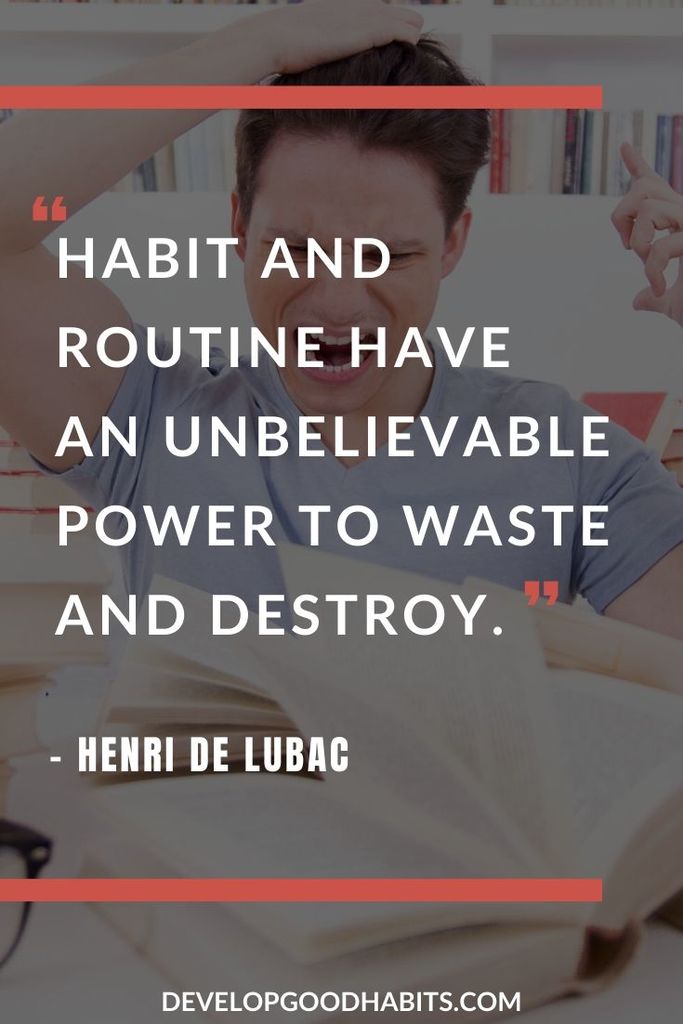There might be affiliate links on this page, which means we get a small commission of anything you buy. As an Amazon Associate we earn from qualifying purchases. Please do your own research before making any online purchase.
The following is an excerpt from my book, 10-Minute Declutter: The Stress-Free Habit for Simplifying Your Home. If you're looking for an an easy, step-by-step plan for sorting, purging, and organizing every space in your house, you need to build the declutter habit first. Read to learn how.
If you want to make sure the declutter habit “sticks,” then you need to follow a specific blueprint for building new habits.
Here's the eight-step plan for building any type of habit.
How to Build the Declutter Habit
Step #1: Focus on the Declutter Habit
There is a concept called ego depletion, which is “a person’s diminished capacity to regulate their thoughts, feelings and actions.”
Ego depletion impacts our ability to form new habits because our supply of willpower is spread out among all the areas of our lives.
Because of this, it’s important to work on only one habit at a time. That way, your store of willpower can be channeled into building that one habit, increasing the odds of success.
Completely focus on the 10-minute declutter habit and avoid adding anything “new” to your schedule.
If you let ego depletion get the best of you, you'll encounter another phenomenon: “what the hell” effect. Watch teh video below to learn all about it:
Step #2: Commit to Decluttering for 30 Days
Some people say it takes 21 days to build a habit, while others claim it takes up to 66 days. The truth is that the length of time really varies from person to person and habit to habit.
You’ll find that some habits are easy to build, while others require more effort. Our advice is to commit to decluttering for the next 30 days (or a month to keep it simple).
Step #3: Anchor Decluttering to an Established Habit
Your decluttering efforts should not be based upon motivation, fads or temporary desire. Instead, decluttering should be instilled in your life to the point it becomes automatic behavior.
The simplest way to do this is to incorporate the teachings of B.J. Fogg and his “Tiny Habits” concept. What you want to do is to commit to a very small habit change and take baby steps as you build on it.
An important aspect of his teaching is to “anchor” the new habit to something you already do on a daily basis.
“After I wake up, I will walk into the targeted room for the day and begin my 10-minute decluttering session.”
“After I put my kids to bed in the evening, I will spend 10 minutes decluttering.”
You get the idea. Simply find a habit you already do consistently, and then anchor your new behavior to it.
Step #4: Pick a Time for Decluttering
The best time to declutter is the time that works best for you. If you work away from home during the day, you’ll need to knock out your 10-minute declutter habit either before or after work.
That said, remember that decluttering habit needs to happen immediately after your trigger so you’ll be reminded to follow through on a daily basis.
Sticking to this trigger is especially important, as you want to create momentum and enjoy the feeling of immediate success. Starting and stopping your clutter-busting commitment will leave you feeling frustrated, which interferes with your brain’s ability to turn it into an automatic action.
Be sure your trigger is something that happens every day (if you want to work on decluttering seven days a week). If you want to skip weekends or declutter every other day, you can certainly do that, but it will take longer for the habit to form. If possible, work on decluttering every day for the first four to six weeks.
If you decide to work on your clutter before you leave for work, the trigger should be something like brushing your teeth, taking your shower or making coffee.
Waking up early is, in itself, a difficult habit to establish. If you have to wake up earlier to add the decluttering habit to your new routine, consider picking a different time to declutter.
If you don’t have trouble waking up early, then the mornings might be a perfect time. Just be sure you set yourself up for success with this new habit by avoiding any pitfalls that might throw you off track.
If you work on your decluttering once you come home from work, choose a time (and trigger) when you are still energized and won’t have many interruptions.
This might be immediately after you walk in the door or right after dinner. If you’re a night owl and get your second wind after 9:00, then you can declutter before going to bed.
Step #5: Take Baby Steps
As discussed in Tiny Habits, the best way to create a new routine is to make micro-commitments and focus on small wins. Motivation alone won’t help.
The danger of relying on motivation alone is that you don’t have a back-up plan for when you’re not in the mood to declutter. Instead, you need to turn the habit into an automatic behavior. A consistent daily habit routine.
So while your long-term goal is to declutter for 10 minutes at a time, you should start slow and focus on building the routine first. It’s more important to stay consistent and not miss a day than it is to do the whole 10 minutes.
Examples include:
Yes, these activities seem overly simplistic. That’s the idea here! You want to commit to something so easy that it’s impossible to miss a day. Then, when you’ve built the habit, you can do the full decluttering routine for 10 minutes.
Step #6: Plan for Your Obstacles
Every new habit routine has obstacles. When you know in advance what your obstacles are, you can take preventive action to overcome them.
Examples of common obstacles:
If you anticipate these obstacles, you won’t be blindsided by them.
The simplest solution is to use a concept called “If-Then Planning” where you create scripts to help you overcome these obstacles. Here are some examples:
“If I’m having trouble completing a morning declutter routine, I will commit to a new time and trigger.”
“If I find myself making multiple trips to the store, I will take time to go through my entire home, write one large shopping list and use it during my next trip to the store.”
“If I’m struggling to eliminate items in one section of my home, I will delay this project and move into a different room.”
See how each of these statements helps you overcome the specific challenges that you face? Our advice is to create similar statements for all the roadblocks that might arise with your daily declutter habit.
Step #7: Create Accountability for Decluttering
Track your decluttering efforts and make public declarations about your new routine.
According to the Hawthorne effect, you’re more likely to follow through with a commitment when you’re being observed by others. To stick with the decluttering habit, you should let others know about your commitment to this habit.
Post updates on social media accounts, use apps like Chains and Coach.me to track your progress, work with an accountability partner or post regular updates to an online community related to the habit.
An accountability partner is somebody who is also interested in your success and can offer personalized help. The video below shows the benefits of having an accountability partner and the five-step process for having long-term success with this type of arrangement.
Do whatever it takes to get reinforcement from others in support of your new routine.
Never underestimate the power of social approval. Simply knowing you will be held accountable for your declutter habit keeps you focused and consistent.
Apps aren't just for accountability though. Check out this list of the best organization apps that can help make developing good habits easier.
Step #8: Reward Important Milestones
Decluttering doesn’t have to be boring. Focus on building a reward system into the process so you can take time to celebrate the successful completion of your goals. The reward you pick is up to you, but it’s important to celebrate those big moments along the way.
Keep in mind that a reward doesn’t have to break the bank. You could check out a new movie, enjoy a night out with your significant other or simply do something you love that doesn’t cost a lot of money.
Final Thoughts on Building Your Declutter Habit
We tend to underestimate the importance of having “fun” while building habits. Often, though, having a clear reward for regularly completing an action will help you to stick to the new routine.
Those are the eight steps for forming the decluttering habit. Simply follow the steps outlined and determine the best time to perform your habit, and you’ll quickly add this routine to your day.
If you're looking for more ideas and tips on how to organize, check out these blog posts:
- 6 Ways to Downsize & Simplify Your Life
- 13 Simple Ways to Successfully Organize Your Life
- 19 Habits of a Highly Organized Personality
Declutter your entire home in just 10 minutes a day. Check out 10-Minute Declutter: The Stress-Free Habit for Simplifying Your Home to help build a declutter habit to reduce the clutter in your home and create new habits to keep it away for good.




Enjoyed the article, will implement today. Thank you.